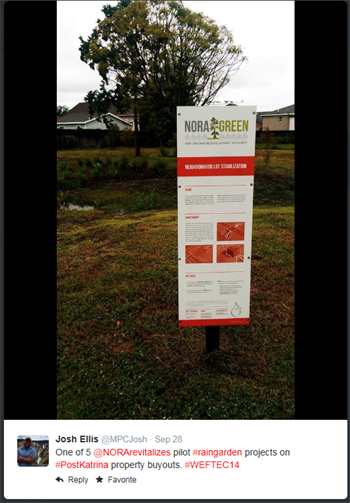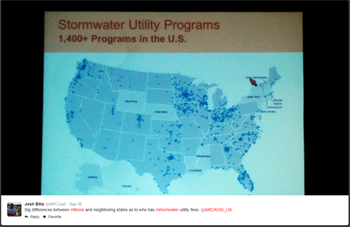This October (and in September, much like real Oktoberfest) the Metropolitan Planning Council’s Josh Ellis is speaking at four conferences about different aspects of MPC’s water resources management work. At the same time, the Johnson Foundation at Wingspread recently culminated six years of its Charting New Waters program, releasing a vision and set of guiding principles requiring “collaborative leadership across sectors and scales.” As Josh explores throughout this series, MPC and its partners are realizing that vision here in northeastern Illinois, with lessons that can be brought to bear well beyond the banks of the Fox River and the shores of Lake Michigan.
Four weeks. Four conferences. Three states. Two watersheds. One boat, one train and lots of planes. One report by the Johnson Foundation to lay out a new vision and principles for water resources management in the U.S. Ten years of the Metropolitan Planning Council’s (MPC) work on water resources to discuss with folks around the country.
What does it all add up to? A busy month, yes, but also a unique opportunity to reflect on a decade of progress, where MPC’s work stands today, and the ways in which our work can influence and be influenced by leading trends in water resources management.
First up, the Water Environment Federation Technical Exhibition and Conference (WEFTEC) in New Orleans in the final days of September. With about 23,000 national and international attendees, WEFTEC is an annual hub of activity and innovation in water quality, wastewater and stormwater management, and increasingly a shift away from those precepts and toward resource recovery. I was there to soak it all in, but also to share some of the preliminary findings from an MPC investigation into the effective (and all too often, ineffective) design of sustainable stormwater management incentive programs aimed at motivating private property owners to retrofit their properties. More on that below.
Coincidentally, WEFTEC was also the venue for the release of the Johnson Foundation’s Navigating to New Shores: Seizing the Future for Sustainable and Resilient U.S. Freshwater Resources, the culmination of its six-year-long Charting New Waters program. The principles espoused in the report—forge partnerships and collaborate to solve problems, design infrastructure to restore ecosystem function, right-size water systems and services, etc.—have long been at the core of MPC’s water resources work.
For me the conference started with a daylong workshop on New Orleans’ post-Katrina water management choices. Through several conversations with David Waggoner, of Waggoner and Ball Architects and one of the leads on Living With Water, the Greater New Orleans Urban Water Plan, it became clear that over-governance and under-governance are at the heart of many unresolved issues there.

One particular post-Katrina frustration is that much of the infrastructure being built today was actually designed and commissioned before that fateful storm. Despite the Living With Water vision, which had robust participation from many government and non-government partners, the reality is that the U.S. Army Corps of Engineers, Sewerage and Water Board of New Orleans, and the New Orleans Dept. of Public Works all see the world a little differently, rely on different funding, and are judged on their success and failures in different ways. Canals that Living With Water envisions as being daylighted, public amenities, and side streets that are envisioned as permeable opportunities for stormwater infiltration are instead getting built as tunnels and boring old streets. Since nobody is fundamentally or solely responsible, that vision has yet to really take hold (similarly, New Orleans is literally sinking, but no unit of government is responsible for tackling subsidence).
MPC increasingly tackles similar instances of over-governance and under-governance—that’s at the heart of our facilitation of the Calumet Stormwater Collaborative: Who’s actually responsible for basement back-ups? Who’s responsible for developing green infrastructure design templates for public works departments? Who’s responsible for that soil and elevation data? Absent the collective agreement of the Collaborative to prioritize those as issues to work on, the answer is “nobody.” What we’re seeing emerge through the Collaborative process, however, is a pretty resounding statement of “We are.” It’s exciting, we just got started, and we’ll see where it goes. We plan to lead our own workshop at WEFTEC next year when it comes to Chicago.
Along the same lines, there were several WEFTEC presentations on efforts to centralize the management of decentralized stormwater infrastructure, particularly green infrastructure. National leaders on green infrastructure—places like Philadelphia, Washington, D.C. and Onondaga County, N.Y.—have developed really solid programs for planning and developing green infrastructure on public properties, though ongoing maintenance and costs continue to press on them. Those places, along with the rest of the world, have to yet to realize the same degree of success when it comes to getting the same green infrastructure built, managed and maintained on private property (which is where most of the rain falls in an urban environment). For many of the WEFTEC attendees I spoke with before and after my presentation, relying on private property owners to maintain publically funded decentralized infrastructure is still too big of a gamble: To really be “infrastructure” it needs to perform in relatively dependable, predictable ways.
As we’re discovering in our research of incentive programs for private property owners across the country, there’s been a lot of progress, but nobody has yet cracked this nut. Several themes are emerging—see the Yes In My Backyard series for more—and as I relayed these during my presentation, the number of heads bobbing up and down in the audience suggests that we might be on to something.
- Intentionality in program design: Educating property owners, keeping a specific volume of stormwater out of your system and reducing runoff in a given area are each distinct, complex goals. What we’re seeing—and we’ve looked at dozens and dozens of programs nationally—is that many programs try to be a little of all of these things, and diminish their impact as a result.
- If your goal is really to achieve some meaningful, long-term impact on a watershed or sewershed, then prioritizing one-on-one interactions with the property owner—the person that will actually own, operate and maintain the green infrastructure in question—is critically important. You need that property owner to be an expert in the system they manage.
- Consider involving third parties that have expertise in anything the utility, public works department or municipal government do not have expertise in (such as education). Hire skilled gardeners to train people to manage native plants, or a community development organization with strong neighborhood ties to show people how to manage rain gardens in parkways and other public right-of-way.
- And finally, don’t be afraid to go back to the drawing board. Iterative program evaluation and design can ensure that if something isn’t working, rather than stick with it because by golly it’s only a matter of time, you change course to something that works. If your impervious surface fee isn’t motivating private property owners to install more green infrastructure, then switch to a cost-share program or some other means instead. That’s more or less what Philadelphia did, and their newly revamped program seems to be leading to much more private property activity.

Of course, designing an effective incentive program to motivate private property owners is not the end-all and be-all of transforming stormwater management. It’s a start, but one of the underlying themes above is also one of the central messages of the Johnson Foundation’s Navigating to New Shores: Utilities as we know them today, with centralized infrastructure systems, primarily volumetric rate-based revenue systems and operations generally hidden from the public eye… well, they might not be the model of the future. Whether we see wholly new utilities, or some other entity whose primary responsibility is centralized management of decentralized infrastructure, is not a matter of if or when, but rather how quickly. Prince George’s County, Maryland, has a pilot program that is already relying on private equity to provide a good portion of the upfront costs of distributed green infrastructure installation, with a performance-based payment system backed by impervious surface fees. More likely than not we’re going to see more of that going forward. It’s also a pretty radical shift for delivery of public infrastructure, at least in stormwater management.
With WEFTEC in the rearview mirror, the next stop is Michigan’s Mackinac Island for the annual conference of the Michigan Association of Planning, where I’ll be exploring a decade of MPC’s work to optimize the use of available water supplies (as the Johnson Foundation calls it) through the creation of a statewide framework for regional water supply planning in Illinois.
Here's where the rest of October took me: